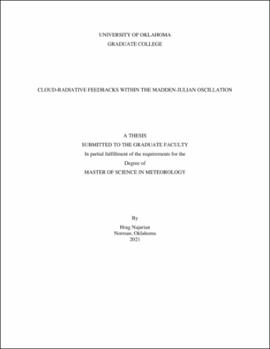| dc.description.abstract | The Madden-Julian Oscillation (MJO) affects weather and climate globally, however it has been challenging to accurately represent it in Global Circulation Models (GCMs) which can lead to uncertainties with future climate projections and long-term forecasts. One of the suggested processes that are important to accurately represent the MJO in GCMs is cloud-radiative feedbacks. Previous studies have suggested the MJO to be a moisture mode, where moisture is the primary factor controlling the growth and propagation of the MJO. An important contributor to moistening within this theory is the atmospheric cloud-radiative heating as it acts to sustain the MJO by moistening the tropospheric column through lifting motions that offset the added diabatic radiative energy. The MJO is also known to have stronger cloud-radiative feedbacks compared to other convectively coupled equatorial waves. The objective of this study is to use observational data from and during the DYNAMO/AMIE field campaign to investigate how cloud-radiative forcing (CRF) evolution differs between wave modes, why the MJO has a unique evolution, and how this relates to MJO dynamics under moisture mode theory.
We found that the MJO shows a structured cloud type evolution, similar to previous results where cloud types began shallow and then deepened and stratified, while the Kelvin and Westward Interio Gravity (WIG) waves saw a less structured cloud type evolution. Interestingly, most cloud types maximize in frequency after the enhanced phase of the MJO, which was not witnessed for the higher frequency wave modes. CRF evolution during the MJO was stronger and lags the enhanced phase compared to higher frequency wave modes. Our linear model which uses cloud type frequency to diagnose CRF accurately replicated CRF evolutions for all wave modes, validating the model’s performance and suggesting the CRF evolution can be diagnosed by simply knowing cloud type evolution. This relationship is important for a moisture mode as this added cloud-radiative heating within wave modes translates to adiabatic lifting, which acts to moisten the tropospheric layer. Cloud-radiative moistening acts to prolong/maintain the enhanced phase of the MJO. The radiatively-driven moistening was decomposed to its contributions by different cloud types and we found that the simultaneous moistening by all cloud types is responsible for the prolonging/maintenance of the enhanced phase of the MJO. This analysis demonstrates the importance of capturing the correct evolution of different cloud types and their radiative effects, which can be used to better understand the dynamics that govern the MJO, overall improving MJO representations in GCMs. | en_US |
